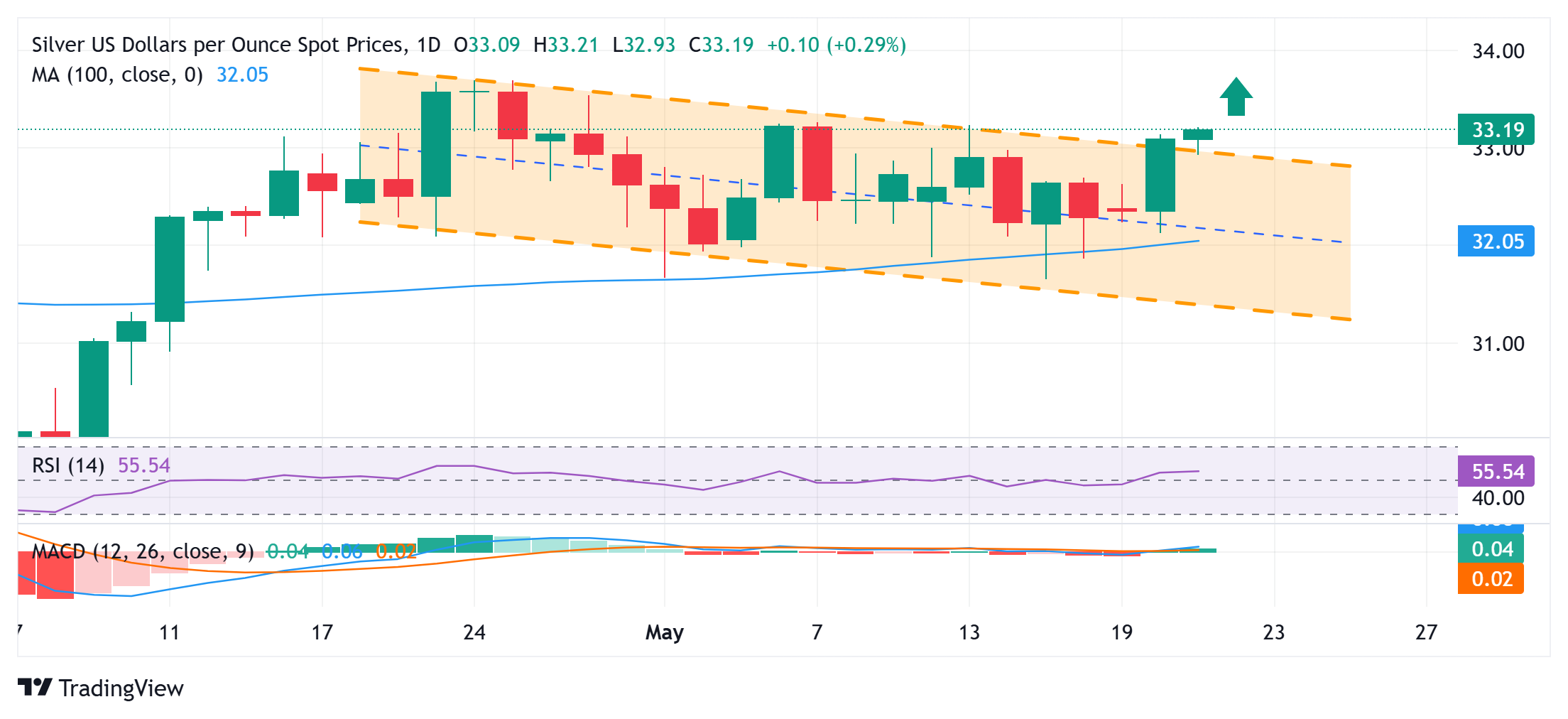Silver Price Forecast: XAG/USD bulls have the upper hand near $33.15-$33.20 area, over one-week top
- Silver attracts some dip-buyers and turns positive for the second straight day on Wednesday.
- The overnight breakout above a short-term ascending trend-channel favors bullish traders.
- Any corrective slide below $33.00 could be seen as a buying opportunity and remain cushioned.
Silver (XAG/USD) reverses an intraday dip to the $33.00 neighborhood and climbs to over a one-week high during the first half of the European session on Wednesday. The white metal currently trades around the $33.15-$33.20 region, up 0.20% for the day, and seems poised to appreciate further.
The emergence of dip-buying validates the previous day's breakout above the top end of a short-term descending trend-channel, which constituted the formation of a bullish flag pattern. Moreover, the recent repeated bounce from the 100-day Simple Moving average (SMA) and the fact that oscillators on the daily chart have just started moving in positive territory validate the near-term positive outlook for the XAG/USD.
Some follow-through buying beyond the $33.60 resistance zone will reaffirm the constructive setup and allow the XAG/USD to aim towards reclaiming the $34.00 round-figure mark. The subsequent move up has the potential to lift the white metal back towards the year-to-date high, around the $34.55-$34.60 zone touched in March.
On the flip side, the ascending channel hurdle breakpoint, around the $33.00 mark, now seems to have emerged as an immediate support. Any further corrective slide could be seen as a buying opportunity and remain limited near the $32.65 horizontal zone. Some follow-through selling, however, would expose the 100-day SMA, currently pegged just above the $32.00 mark, which, if broken, might pave the way for further losses.
Meanwhile, the lower boundary of the aforementioned trend-channel, currently around the $31.40 region, should act as a strong near-term base for the XAG/USD. A convincing break below the latter, however, will negate the positive outlook and shift the near-term bias in favor of bearish traders.
Silver daily chart

Silver FAQs
Silver is a precious metal highly traded among investors. It has been historically used as a store of value and a medium of exchange. Although less popular than Gold, traders may turn to Silver to diversify their investment portfolio, for its intrinsic value or as a potential hedge during high-inflation periods. Investors can buy physical Silver, in coins or in bars, or trade it through vehicles such as Exchange Traded Funds, which track its price on international markets.
Silver prices can move due to a wide range of factors. Geopolitical instability or fears of a deep recession can make Silver price escalate due to its safe-haven status, although to a lesser extent than Gold's. As a yieldless asset, Silver tends to rise with lower interest rates. Its moves also depend on how the US Dollar (USD) behaves as the asset is priced in dollars (XAG/USD). A strong Dollar tends to keep the price of Silver at bay, whereas a weaker Dollar is likely to propel prices up. Other factors such as investment demand, mining supply – Silver is much more abundant than Gold – and recycling rates can also affect prices.
Silver is widely used in industry, particularly in sectors such as electronics or solar energy, as it has one of the highest electric conductivity of all metals – more than Copper and Gold. A surge in demand can increase prices, while a decline tends to lower them. Dynamics in the US, Chinese and Indian economies can also contribute to price swings: for the US and particularly China, their big industrial sectors use Silver in various processes; in India, consumers’ demand for the precious metal for jewellery also plays a key role in setting prices.
Silver prices tend to follow Gold's moves. When Gold prices rise, Silver typically follows suit, as their status as safe-haven assets is similar. The Gold/Silver ratio, which shows the number of ounces of Silver needed to equal the value of one ounce of Gold, may help to determine the relative valuation between both metals. Some investors may consider a high ratio as an indicator that Silver is undervalued, or Gold is overvalued. On the contrary, a low ratio might suggest that Gold is undervalued relative to Silver.

